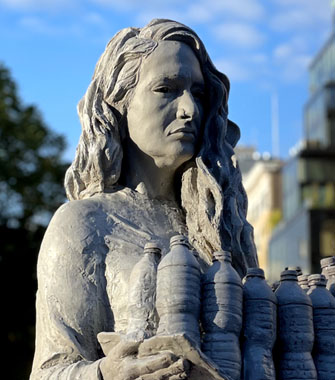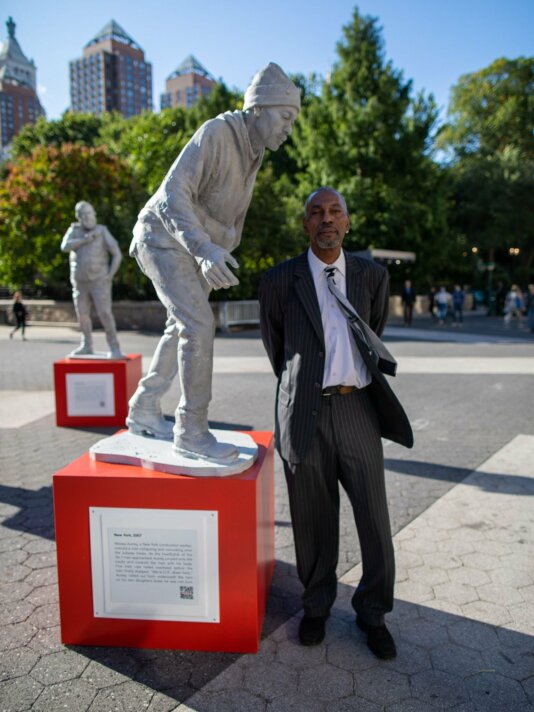- About
- Topics
- Picks
- Audio
- Story
- In-Depth
- Opinion
- News
- Donate
-
Signup for our newsletterOur Editors' Best Picks.Send
Read, Debate: Engage.
| October 07, 2021 | |
|---|---|
| topic: | Arts |
| tags: | #I Am Your Protector, #xenophobia, #Islamophobia, #refugees, #BLM, #Anti-racism, #NGO, #USA |
| located: | USA |
| by: | Gerardo Bandera |
“I believe in the power of narrative to shape emotion, and emotion to shape our actions and reality.” This is how Leila, one of the organisers working the exhibition on Thursday, explained her involvement with I Am Your Protector (IAYP). She comes from a part of the world where people are pitted against each other for racial or religious reasons, so when she heard about this campaign that brings people together, she felt “compelled to help.”
Using compelling narratives to change peoples’ perceptions of other communities is exactly IAYP’s mission. In the past, it has organised worldwide Holocaust remembrance ceremonies honouring Muslim individuals who helped save Jewish lives, a theatrical performance in Times Square of real-life heroical feats by ‘minority’ groups, and a virtual art installation that was only visible using special glasses - inviting people to “see things differently.” This past week, it arranged a pop-up installation in New York City to honour heroic acts by everyday people.
I Am Your Protector’s mission is, in part, a reaction to the media frenzy and political fervour that dramatise criminal events and exaggerate the foreignness or danger of different groups, such as minorities, undocumented immigrants, refugees and people facing homelessness. These misrepresentations are not without their consequences - they amplify sentiments of fear and mistrust of already vulnerable communities, therefore making them subjects of xenophobic vitriol, hate crimes and institutionalised discrimination.
These types of prejudiced attacks on groups of people have been on the rise worldwide as politicians and media outlets capitalise on nationalist fanaticism and sectarianism. In the US alone, attacks on muslim individuals have soared in the last five years, hispanic unauthorised immigrants have been portrayed by politicians as ‘rapists and criminals’ - despite being less likely to commit crimes - and, unforgettably, numerous African Americans have been victims of police brutality and unjust persecution.
This trend is not limited to the US: in Europe, anti-semitic attacks have also seen a spike and Syrian and Afghan refugees have been met with closed doors, while in India, the ruling party’s Islamophobic rhetoric and regulations have resulted in increased hate crimes.
This rise in discrimination from cultural fragmentation is exactly what I Am Your Protector seeks to counteract. By exposing the heroic and compassionate stories of members of these misrepresented communities who have “shown bravery and risked their own lives” to help others, no matter their affiliation, they hope to demonstrate that no group or denomination is homogenous and to thereby strip people of the discriminatory perceptions fostered by biased outlets.
On 30 September, busy New Yorkers were stopped in their tracks at Union Square by a salient pop-up exhibition. Entitled “Protector Monuments: Reclaim the Pedestal,” the cultural display consisted of five sculptures elevated on bright red pedestals, each depicting protectors from different parts of the world and explaining their stories.
Among the protectors was Antonio Diaz Chacon, a twenty-three-year-old undocumented immigrant from Mexico who “chased down an alleged child abductor” and rescued a six-year-old girl. Another statue commemorated Mohsen Alwais, a Syrian refugee who bravely “jumped into freezing water to save a drowning man,” despite not knowing how to swim too well. The exhibition also included a sixth empty pedestal that invited bystanders to participate and share their own stories of being protectors, or of protectors they know.
The volunteer-based community commissioned two artists for the sculptures: Joseph Reginella, who was dubbed the “Banksy of Monuments” by the New York Times, molded the bodies of the protectors, while sculptor Alvin Pettit fashioned their faces. “I made the sculptures life-sized and very realistic so that they would feel real and have an emotional effect,” Reginella told FairPlanet.
And indeed, many spectators mistook the sculptures for real people, which added to the sentimental impact and humanised the stories. “The response has been emotional and compelling,” Leila described. “Because the stories are real and human, people think ‘this could happen to me’ or ‘I could be a protector.’” Following such an emotional response, many people were inspired to share their own stories.
Another volunteer, Niceli Portugal, told a moving story of a young girl who came up to the statue of Mohsen Alwais and exclaimed “I’ve never looked up to a refugee on a pedestal before.” Niceli, who is also an artist, explained that having these everyday people, especially immigrants and refugees, honoured on pedestals and tower above the spectator elicits a powerful emotional response and contrasts with the demographic and achievements of most of the sculptures we typically see.
Seeing these sculptures at Union Square - a historic cultural junction - was all the more powerful as they were accompanied on the Southern side by new commemorative sculptures of George Floyd, Breonna Taylor and John Lewis. It served to show that even in New York - a city in which many social, political and cultural groups live closely together, but that nonetheless experiences cultural fragmentation and discrimination - it is still important to actively deconstruct prejudiced ideas.
Many humanitarian organisations help victims of bigotry and xenophobia recover from mistreatment and others seek to reform laws for institutional change. However, I Am Your Protector’s approach works on a more subtle, subconscious level: by striking an emotional chord with human stories, it connects people on a sectless level and erodes prejudices - thereby preventing future discrimination and violence onto vulnerable groups.
I Am Your Protector believes that anybody, from any denomination, can be a protector and encourages people who have either been a protector, or know someone who has, to share their story on their website.
Image by: Joe Reginella
By copying the embed code below, you agree to adhere to our republishing guidelines.


